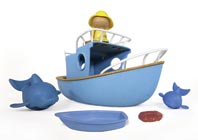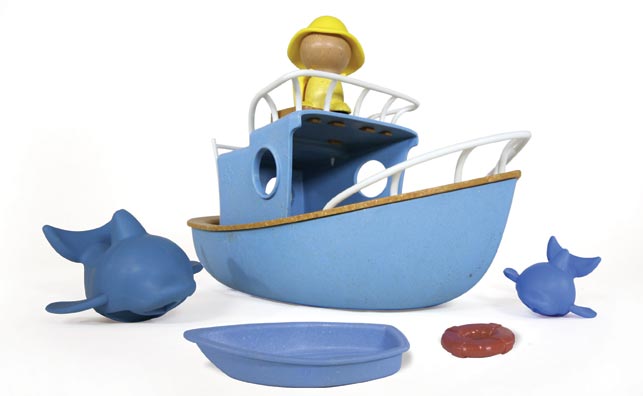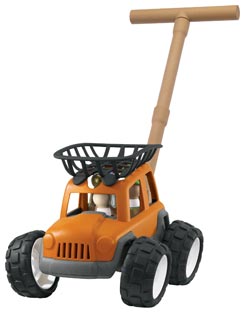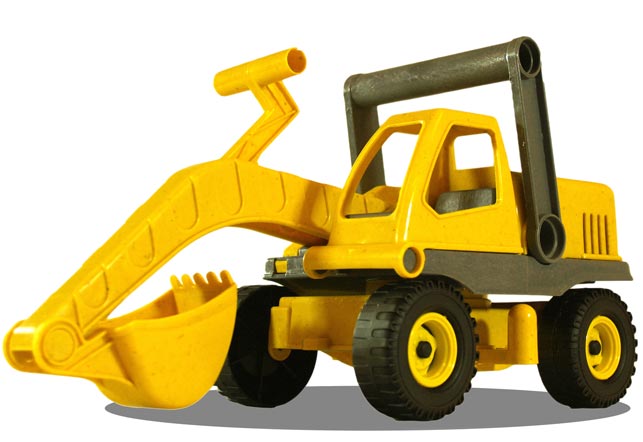Interview with Justin Discoe, Sprig’s co-founder
Toy designers Justin Discoe, Chris Clemmer and David Bowen decided to set up their own eco-friendly toy company having visited the factories in China that turned their toy designs into real products. They soon realised the harmful impact toy production had on the environment and so set up Sprig in Fort Collins, Colorado, with the aim of making children’s toys, the right way.
The company launched in 2007 with its first product range – the Sprig Adventure Series. The toys are made from Sprigwood, a proprietary bio-composite of recycled wood and reclaimed plastic. The material has visible wood ‘flecks’ and also gives the toys a fresh, woody scent.
This range of battery-free vehicles gets preschoolers off the couch and engaged in active, imaginative play. Through pushing or pumping, an internal generator is activated , which powers the electronics. ‘Adventure Guides’ plug into the driver’s seats via a USB port and play music and story snippets.
Following the successful launch and a number of awards, further ranges have been launched including Eco-Trucks, Sprig Hollow and Story Builders.
The company claims that its deeply dedicated to solving environmental impact issues through innovative design. The company uses recycled materials whenever possible and manufactures its products in Europe and North America to reduce its carbon footprint.

The US Toy Industry Association awarded the Sprig Dolphin Explorer Boat as the Toy of the Year 2010
D3D: You worked in the consumer products business for quite some time before setting up Sprig. What made you want to set up an eco-friendly company?
Justin Discoe: Personally, having children made me really think about the products my wife and I bought and as a product designer, the products I was making. Back then I had a small, but successful design consultancy and designed a lot of toys that didn’t need to be made. But it was my job to design them and make them the coolest they could be – design after all is a job and we have families to provide for. Designing toys started to become an endless cycle of deadlines and lining up the next project. That is until my son came into our little studio one afternoon, which I ran from the shed on our farm. Charlie was in kindergarten and used to come down from the house to hang out with the guys, see what we were up to and play with the plethora of toys we kept around. One day he was pushing a big steel Tonka dump truck all over the fields and back and collectively we thought, “What if we could capture that energy? We wouldn’t need batteries!” And Sprig’s first product was born, the Discover Rig, an electronic preschool vehicle that creates its electricity by harnessing the child’s motion through a dynamo and capacitor system. We didn’t stop there, saving the earth from disposable batteries is awesome, but what about the materials we use? We found a Canadian company that was making wood-plastic composites from reclaimed wood and recycled plastic, but extruding it – not injection moulding. We worked for 9 to 10 months with them perfecting the formula to make it feasible for toy manufacturing.
D3D: It states on your website that you use ‘eco-friendly materials’ one of which is Sprigwood. What exactly is it and where do you source it from?

The ‘Sprig Adventure Series’ is built around the Discover Rig – a sturdy, battery-free vehicle with a removable push bar.
Justin Discoe: Sprigwood is a mix of reclaimed wood and recycled PP plastic. How its mixed together and blended is a trade secret for us and manufactured by our partner MGP in Kansas (USA). The materials are sourced in the USA. We are able to use less recycled plastic by using the reclaimed wood, which means that 20 to 30% of our toys come from a renewable resource. We also collect from resources like saw dust from furniture factories in the States. The Sprigwood also moulds at a lower temperature than traditional plastic, so we have on average a 20% savings on the energy used to do our injection moulding. Besides all that, it just smells good – our toys smell like your father’s wood shop.
D3D: What other materials are used in the design of the toys?
Justin Discoe: We are taking a deep look into a completely biodegradable toy, that would be a natural next step for us. Suppliers have materials that will work, but it is really finding the balance of ecology and raw material price. Consumers are still a bit gun-shy about spending more for an eco-friendly product and buyers at the retailer level really haven’t embraced green like we had hoped. One of the easiest steps that any consumer products company can take is reducing the amount of packaging for products and using recycled cardboard and getting rid of those dreaded wire-ties and zip-ties! We have never used wire ties or zip ties and get praise from our customers all the time.
D3D: Do you conduct Life Cycle assessment on the products and their production/shipping? If so, how do you go about it?
Justin Discoe: We would love to be able to conduct life cycle testing in-house, but that process is handled by our vendor partners. We are still a very small company and rely on a our partners to handle that. We focus on what we are good at, which is designing toys.

The excavator is part of the Sprig Eco-Trucks range. This range is fully equipped with flip-open cabs and easy-grab handles, making each freewheeling vehicle inviting and a cinch to maneuver for children aged three years and older.
D3D: Your products are obviously eco-freindy but what about the manufacturing process itself? Is that process also kind to the environment?
Justin Discoe: The major process is injection moulding, so by the very nature of doing so you create tooling made from huge chunks of steel, ship recycled raw materials here and there, create packaging, print the packaging, ship the packaging to the factory and then injection mould the parts and assemble and ship out the retailers. The process is pretty much set, but the “kinder” bit we have is the raw material itself – the Sprigwood. Because of the raw materials that go into making it, we are able to do our injection moulding at a much lower temperature than standard with plastic or even recycled plastics. So we are able to have an average energy savings of 20%. In our business, that is huge and the factories like it too as basic energy prices skyrocket.
D3D: Any lessons that you have learned during the Sprig toys’ product development process that you’d be willing to share to help others embarking on a sustainable design process?
Justin Discoe: Find something that makes you different – not only to consumers, but to the buyers at retail level. We managed to build a great little brand that competes with “regular” toys and even won a Toy Of The Year award in 2010 for our Dolphin Explorer Boat, not because it was eco-friendly, but because it is a good toy. Your products have to be good and stand by themselves on the products merits, not because it is eco-friendly. Another tip, don’t be afraid to ask questions. Generally, people are helpful and we learned a lot by not being afraid to just ask.
Interview with Justin Discoe, Sprig’s co-founder
No






